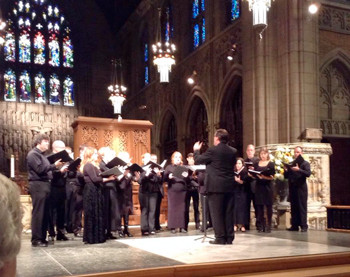by Nicholas Jones

Contrapunctus is the reincarnation of an earlier vocal ensemble, Cantores Cleveland, with a name change and a new director. David Acres, an English singer and choral conductor, led the ensemble in their third Cleveland concert last weekend.
Generally, one hears Purcell only in snippets — an anthem here or there, and perhaps his opera Dido and Aeneas. Contrapunctus’s splendid all-Purcell concert on Sunday afternoon in Trinity Cathedral offered parts or all of thirteen of his vocal compositions.
There is a great deal to pick from: in his short life, 1659-1695 (you can remember his death year by reversing the last two digits of his birth), Purcell produced a remarkable 150 sacred anthems, as well as operas, incidental music for the theater, chamber music, and occasional pieces for the British royalty and aristocracy.
From that abundance, David Acres chose wisely: a combination of well-known and rarely-performed pieces, and a mix of wholly choral pieces with solos and small ensembles.
Contrapunctus sang with a translucent clarity. This was an almost-entirely English-language program, so diction mattered, and the words carried nicely, even far down the nave of the cathedral. Their intonation was excellent, and the parts were superbly balanced, letting us hear the inner voices without strain.
Acres, himself a longtime chorister in the English cathedral tradition, conducted with a brisk sense of tempo and a steady beat, and knew how to stay out of the way — no histrionics here! He brought to the performances a strong sense of the musical structure of each piece — partly conveyed by his extensive and informative program notes, but more importantly by the choir’s obvious and effective engagement with Purcell’s intricate musical architecture.
Contrapunctus performed some of the greatest of Purcell’s anthems, written for a Chapel Royal that must have appreciated their artistry and their intensity. Hear my prayer, O Lord is a 8-voice masterpiece that packs an emotional punch, though setting only a single line of psalm text. Remember not, O Lord, our offenses is another familiar masterwork, loaded with Purcell’s signature chromaticism and expressive dissonance.
With the exception of a few secular pieces — the sprightly Come, ye sons of art is justly one of the most famous — the program focused on Purcell’s sacred music. In the aftermath of the anti-musical Puritan republic, Purcell was one of the key figures in restoring the primacy of music in the Anglican services of the capital city. Pieces like I was glad and Rejoice in the Lord always — written for London congregations eager to forget the repressive years of Cromwell, and which still resonate with energy and verve — were elegantly conveyed by Contrapunctus, with springing rhythms and energetic harmonies.
Many of the pieces showed Purcell’s masterful appropriation of the multiple musical traditions of the later 17th century. One of the joys of this program was to watch how this skilled and highly practical composer melded the florid expression of the Italian style with a native, English text-based tradition. Purcell — and Contrapunctus — moved flexibly from English homophony (hymn settings) to German-inflected counterpoint (though never as extended as Bach), and from classical Renaissance polyphony (think Palestrina and Byrd) into extravagant soloistic arias reminiscent of late Monteverdi.
Much of the program was accompanied by Trinity’s choir organ, but a string ensemble would have been far more accurate to Purcell’s scores, and more effective. The organ, positioned at the back of the performance space, sometimes covered up rhythmic nuances in the singing, and its equal-tempered tuning dictated pitches for intervals that would have been more expressive in unequal temperaments. On occasion the organ also missed the director’s cadential cues.
Performing under the high space of the transept crossing in the resonant acoustics of Trinity Cathedral, the twenty-odd voices of Contrapunctus sounded at their best when singing all together without accompaniment. The many small ensembles and the occasional soloist, drawn from the highly accomplished ensemble, usually sang from the back of the performance space, and as a result projected less effectively than if they had moved to the front.
Overall, however, hearing this much of the powerful music of the great Purcell, so elegantly sung and with such care for its structure and meaning, was a great treat. May Contrapunctus thrive — “Come, ye sons of art!”
Published on ClevelandClassical.com October 6, 2014.
Click here for a printable copy of this article.




